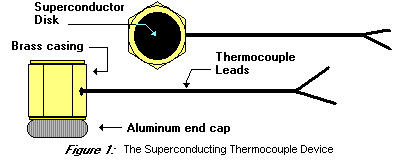There are several ways that the Critical Temperature can be measured. One effective and elegant way is to use the Meissner Effect. The superconducting devices with attached thermocouple probes in both the Critical Temperature Kit and the Critical Temperature Comparison Kit are designed for this purpose.
The superconducting thermocouple device is encapsulated in a metal casing. We have designed this casing to impart greater thermal and mechanical stability to the device. The top of the device is the brass portion which shows a flat surface of the black superconductor disk. See figure 1 below for details.
Measuring the Critical Temperature using the Meissner Effect
The following procedure will guide you through the measurement of the Critical Temperature of the superconductor step by step.
Procedure
- ACTION
Carefully straighten the thermocouple leads and attach them to a voltmeter which can measure and display in the 0.01 milivolt range. - ACTION
Immerse the device completely in liquid nitrogen. The thermocouple should read +6.43 milivolts, corresponding to the liquid nitrogen temperature of 77 K. - ACTION
Remove the device from the liquid nitrogen and place it flat on a non-conducting surface with the black superconductor exposed on the top surface. - ACTION
Carefully balance the cobalt-samarium magnet so that it 'floats' via the Meissner Effect levitation over the center of the disk. - ACTION
Keep the magnet under careful observation while recording the voltmeter reading at 5 second intervals. This part is best performed with the aid of a lab partner. You may have to center the magnet periodically with the tweezers.
RESULT
For several minutes the magnet stays levitated. During this time the voltmeter reading begins to show a gradual increase in temperature. After a while, the magnet begins to drop, and finally comes to rest on the surface of the superconductor. The temperature as measured by the voltmeter at the time when the magnet has just come to a complete rest on the surface of the superconducting device, is the Critical Temperature (Tc), for the superconductor.
Precautions
- Be careful not to let the liquid nitrogen splash or spill when you pour it. Read the handling guidelines before using liquid nitrogen.
- Use the provided non-magnetic tweezers when handling the device or magnet.
- The electrical leads of the thermometer are delicate. Do not pull them, or twist or bend them unnecessarily. Bend the wires only before the device is cooled in the liquid nitrogen. Remember to keep the thermocouple-to- voltmeter-leads connection at room temperature.
One of the mysteries of these new superconductors is that they do not have sharply defined Critical Temperatures. Typically, the transition from normal to superconducting state takes place over a range of about 5 degrees Kelvin. The critical temperature that you just measured falls in this range, with a reading of about 94 Kelvin for YBa2Cu3O7, and about 108 Kelvin for Bi2Sr2Ca2Cu3O10.
We suggest that you use clean alligator clips to attach the thermocouple leads to the voltmeter leads. These connection points should be kept dry and at room temperature. The thermocouple has been carefully attached and packed inside the metal device casing. Please do not attempt to open the casing, or else the thermocouple junction will no longer be in good thermal contact with the superconductor.
It appears that in ceramic superconductors, the Meissner Effect is a bulk phenomena. Consequently, if any portion of the superconductor is below its Critical Temperature, the resultant Meissner Effect for that portion of the material will repel the magnet. The top surface of the superconductor disk warms first and looses its superconductivity as the liquid nitrogen evaporates. Other parts of the superconductor disk are still below the Critical Temperature, and thus continue to repel the magnet. However, since these parts are further from the magnet, it is levitated less. As the disk warms further, the magnet floats lower and lower, until the bottom of the disk is finally warmer than the Critical Temperature, at this point the magnet finally comes to rest on the top surface of the disk. Therefore, when the magnet to a complete rest on the surface of the superconductor, the bottom part of the disk is at the Critical Temperature.
Some Questions
- Under some circumstances, the magnet will abruptly scoot to one side of the device as it warms. Can you think of an explanation for this?
- The device develops a layer of frost only after the liquid nitrogen has all boiled away. Why is this?
- Try the experiment by first placing the magnet on the superconducting device, and then cooling it down in liquid nitrogen. Do you observe any differences in the Critical Temperature? If so, why?
- The application of the Meissner Effect to measure the Critical Temperature was just one possible application of this effect. Can you think of other, elegant applications of this unique Effect?

Information Courtesy of CSI Superconductors

